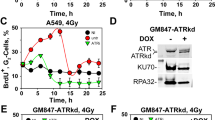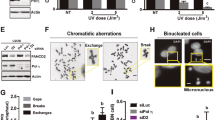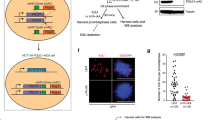Abstract
To preserve genetic integrity, mammalian cells exposed to ionizing radiation activate the ATM kinase, which initiates a complex response—including the S-phase checkpoint pathways—to delay DNA replication1,2. Defects in ATM or its substrates Nbs1 or Chk2 (ref. 3), the Nbs1-interacting Mre11 protein4, or the Chk2-regulated Cdc25A-Cdk2 cascade all cause radio-resistant DNA synthesis (RDS)5,6. It is unknown, however, whether these proteins operate in a common signaling cascade. Here we show that experimental blockade of either the Nbs1-Mre11 function or the Chk2-triggered events leads to a partial RDS phenotype in human cells. In contrast, concomitant interference with Nbs1-Mre11 and the Chk2-Cdc25A-Cdk2 pathways entirely abolishes inhibition of DNA synthesis induced by ionizing radiation, resulting in complete RDS analogous to that caused by defective ATM. In addition, Cdk2-dependent loading of Cdc45 onto replication origins, a prerequisite for recruitment of DNA polymerase7,8, was prevented upon irradiation of normal or Nbs1/Mre11-defective cells but not cells with defective ATM. We conclude that in response to ionizing radiation, phosphorylations of Nbs1 and Chk2 by ATM trigger two parallel branches of the DNA damage-dependent S-phase checkpoint that cooperate by inhibiting distinct steps of DNA replication.
This is a preview of subscription content, access via your institution
Access options
Subscribe to this journal
Receive 12 print issues and online access
$209.00 per year
only $17.42 per issue
Buy this article
- Purchase on Springer Link
- Instant access to full article PDF
Prices may be subject to local taxes which are calculated during checkout






Similar content being viewed by others
References
Rotman G. & Shiloh, Y. ATM: a mediator of multiple responses to genotoxic stress. Oncogene 18, 6135–6144 (1999).
Kastan, M.B. & Lim, D.S. The many substrates and functions of ATM. Nature Rev. Mol. Cell Biol. 1, 179–186 (2000).
Khanna, K.K. & Jackson, S.P. DNA double-strand breaks: signaling, repair and the cancer connection. Nature Genet. 27, 247–254 (2001).
Petrini, J.H. The Mre11 complex and ATM: collaborating to navigate S phase. Curr. Opin. Cell Biol. 12, 293–296 (2000).
Stewart, G.S. et al. The DNA double-strand break repair gene hMRE11 is mutated in individuals with an ataxia-telangiectasia-like disorder. Cell 99, 577–587 (1999).
Falck, J., Mailand, N., Syljuåsen, R.G., Bartek, J. & Lukas, J. The ATM-Chk2-Cdc25A checkpoint pathway guards against radioresistant DNA synthesis. Nature 410, 842–847 (2001).
Walter, J. & Newport, J. Initiation of eukaryotic DNA replication: origin unwinding and sequential chromatin association of Cdc45, RPA, and DNA polymerase α. Mol. Cell 5, 617–627 (2000).
Takisawa, H., Mimura, S. & Kubota, Y. Eukaryotic DNA repliation: from pre-replication complex to initiation complex. Curr. Opin. Cell Biol. 12, 690–696 (2000).
Larner, J.M. et al. Radiation down-regulates replication origin activity throughout the S phase in mammalian cells. Nucleic Acids Res. 27, 803–809 (1999).
Painter, R.B. & Young, B.R. Radiosensitivity in ataxia-telangiectasia: a new explanation. Proc. Natl Acad. Sci. USA 77, 7315–7317 (1980).
Sarkaria, J.N. et al. Inhibition of ATM and ATR kinase activities by the radiosensitizing agent, caffeine. Cancer Res. 59, 4375–4382 (1999).
Blasina, A., Price, B.D., Turenne, G.A. & McGowan, C.H. Caffeine inhibits the checkpoint kinase ATM. Curr. Biol. 9, 1135–1138 (1999).
Melchionna, R., Chen, X.B., Blasina, A. & McGowan, C.H. Threonine 68 is required for radiation-induced phosphorylation and activation of Cds1. Nature Cell Biol. 2, 762–765 (2000).
Matsuoka, S. et al. Ataxia telangiectasia-mutated phosphorylates Chk2 in vivo and in vitro. Proc. Natl Acad. Sci. USA 97, 10389–10394 (2000).
Aparicio, O.M., Stout, A.M. & Bell, S.P. Differential assembly of Cdc45p and DNA polymerases at early and late origins of DNA replication. Proc. Natl Acad. Sci. USA 96, 9130–9135 (1999).
Zou, L. & Stillman, B. Assembly of a complex containing Cdc45p, replication protein A, and Mcm2p at replication origins controlled by S-phase cyclin-dependent kinases and Cdc7p-Dbf4p kinase. Mol. Cell. Biol. 20, 3086–3096 (2000).
Costanzo, V. et al. Reconstitution of an ATM-dependent checkpoint that inhibits chromosomal DNA replication following DNA damage. Mol. Cell 6, 649–659 (2000).
Kukimoto, I., Igaki, H. & Kanda, T. Human CDC45 protein binds to minchromosome maintenance 7 protein and the p70 subunit of DNA polymerase α. Eur. J. Biochem. 265, 936–943 (1999).
Trivedi, A., Waltz, S.E., Kamath, S. & Leffak, M. Multiple initiations in the c-myc replication origin independent of chromosomal location. DNA Cell Biol. 17, 885–896 (1998).
Tao, L., Dong, Z., Leffak, M., Zannis-Hadjopoulos, M. & Price, G. Major DNA replication initiation sites in the c-myc locus in human cells. J. Cell. Biochem. 78, 442–457 (2000).
Lim, D. et al. ATM phosphorylates p95/nbs1 in an S-phase checkpoint pathway. Nature 404, 613–617 (2000).
Zhao, S. et al. Functional link between ataxia-telangiectasia and Nijmegen breakage syndrome gene products. Nature 405, 473–477 (2000).
Wu, X. et al. ATM phosphorylation of Nijmegen breakage syndrome protein is required in a DNA damage response. Nature 405, 477–482 (2000).
Gatei, M. et al. ATM-dependent phosphorylation of nibrin in response to radiation exposure. Nature Genet. 25, 115–119 (2000).
Maser, R.M. et al. The Mre11 complex and DNA replication: linkage to E2F and sites of DNA synthesis. Mol. Cell. Biol. 21, 6006–6016 (2001).
Xu, B., Kim, S. & Kastan, M.B. Involvement of Brca1 in S-phase and G2-phase checkpoints after ionizing irradiation. Mol. Cell. Biol. 21, 3445–3450 (2001).
Carr, A.M. Cell cycle. Piecing together the p53 puzzle. Science 287, 1765–1766 (2000).
Hoeijmakers, J.H. Genome maintenance mechanisms for preventing cancer. Nature 411, 366–374 (2001).
Sørensen, C.S. et al. Nonperiodic activity of the human anaphase-promoting complex-Cdh1 ubiquitin ligase results in continuous DNA synthesis uncoupled from mitosis. Mol. Cell. Biol. 20, 7613–7623 (2000).
Méndez, J. & Stillman, B. Chromatin association of human origin recognition complex, Cdc6, and minchromosome maintenance proteins during the cell cycle: assembly of prereplication complexes in late mitosis. Mol. Cell. Biol. 20, 8602–8612 (2000).
Acknowledgements
We thank J. Mendez, I. Kukimoto, Y. Shiloh, D. Delia, S. J. Elledge, M.B. Kastan and G. Evan for providing technical advice and reagents, and the Danish Cancer Society and Læge Sofus Carl Emil Friis og Hustru Olga Doris Friis's Legat for financial support. This work was supported in part by a grant from the National Institutes of Health (to J.H.J.P.).
Author information
Authors and Affiliations
Corresponding author
Supplementary information
Rights and permissions
About this article
Cite this article
Falck, J., Petrini, J., Williams, B. et al. The DNA damage-dependent intra–S phase checkpoint is regulated by parallel pathways. Nat Genet 30, 290–294 (2002). https://doi.org/10.1038/ng845
Received:
Accepted:
Published:
Issue Date:
DOI: https://doi.org/10.1038/ng845
This article is cited by
-
Redox dysregulation as a driver for DNA damage and its relationship to neurodegenerative diseases
Translational Neurodegeneration (2023)
-
Caspase-2 regulates S-phase cell cycle events to protect from DNA damage accumulation independent of apoptosis
Oncogene (2022)
-
DNA damage response signaling pathways and targets for radiotherapy sensitization in cancer
Signal Transduction and Targeted Therapy (2020)
-
Investigation of dose-rate effects and cell-cycle distribution under protracted exposure to ionizing radiation for various dose-rates
Scientific Reports (2018)
-
Resveratrol inhibits Extranodal NK/T cell lymphoma through activation of DNA damage response pathway
Journal of Experimental & Clinical Cancer Research (2017)



